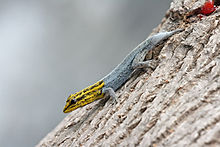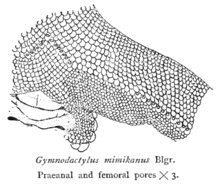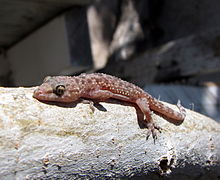- Gecko
-
This article is about the type of animal. For other uses, see Gecko (disambiguation).
Gecko
Temporal range: 50 Ma - Recent, putatively as early as 110 Ma[1]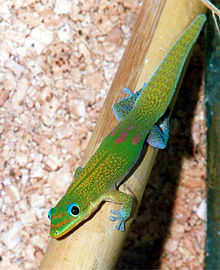
Gold dust day gecko (also known as Madagascar day geckos) Scientific classification Kingdom: Animalia Phylum: Chordata Class: Reptilia Order: Squamata Suborder: Scleroglossa Infraorder: Gekkota Family: Gekkonidae
Gray, 1825Subfamilies Aeluroscalabotinae
Eublepharinae
Gekkoninae
Teratoscincinae
DiplodactylinaeGeckos are lizards belonging to the family Gekkonidae, found in warm climates throughout the world. They range from 1.6 cm to 60 cm.
Geckos are unique among lizards in their vocalizations, making chirping sounds in social interactions with other geckos. Gekkonidae is the largest family of lizards, with over 2000 different species worldwide and many others likely yet to be discovered. The New Latin gekko and English gecko stem from the Malay gēkoq, which is imitative of the sound the animals make.[2]
All geckos, excluding the Eublepharinae subfamily, have no eyelids and instead have a transparent membrane which they lick to clean. Many species will, in defense, expel a foul-smelling material and feces onto their aggressors. There are also many species that will drop their tails in defense, a process called autotomy. Many species are well known for their specialized toe pads that enable them to climb smooth and vertical surfaces, and even cross indoor ceilings with ease (one hypothesis explains the ability in terms of the van der Waals force). These antics are well-known to people who live in warm regions of the world, where several species of geckos make their home inside human habitations. These species (for example the House Gecko) become part of the indoor menagerie and are often welcome guests, as they feed on insects, including mosquitoes. Unlike most lizards, geckos are usually nocturnal and are great climbers.
The largest species, the Kawekaweau, is only known from a single, stuffed specimen found in the basement of a museum in Marseille, France, and one documented sighting in the wild in 1870. This gecko was 60 cm (24 in) long and it was endemic to New Zealand, where it lived in native forests. It was probably wiped out along with much of the native fauna of these islands in the late 19th century, when new invasive species such as rats and stoats were introduced to the country during European colonization. The smallest gecko, the Jaragua Sphaero, is a mere 1.6 cm long and was discovered in 2001 on a small island off the coast of the Dominican Republic.[3]
Contents
Common traits
Geckos come in various patterns and colors such as purple, pink, blue, and black, and are among the most colorful lizards in the world.
Some are subtly patterned and somewhat rubbery looking, while others are brightly colored. Some species can change color to blend in with their environment or with particular temperatures. Some species are parthenogenic, which means the female is capable of reproducing without copulating with a male. This improves the gecko's ability to spread to new islands. However, in a situation where a single female gecko populates an entire island, the island will suffer from a lack of genetic variation within the geckos that inhabit it. The gecko's mating call sounds like a shortened bird chirping which attracts males, when they are around. This allows a female to reproduce with more genetic variation, by using sexual reproduction instead of asexual.
Adhesion Ability
The toes of the gecko have a special adaptation that allows them to adhere to most surfaces without the use of liquids or surface tension. The spatula tipped setae on gecko footpads allow attractive forces called van der Waals interactions to arise between the adhesive setae and the surface. One study suggested that capillary adhesion might play a role,[4] but that hypothesis has been rejected by more recent studies.[5][6][7]
These van der Waals interactions involve no fluids; in theory, a boot made of synthetic setae would adhere as easily to the surface of the International Space Station as it would to a living room wall, although adhesion varies with humidity.[6][7] The setae on the feet of geckos are also self cleaning and will usually remove any clogging dirt within a few steps.[8][9] Teflon, which has very low van der Waals forces,[10] is more difficult for geckos to adhere to than many other surfaces.
Geckos' toes seem to be "double jointed", but this is a misnomer. Their toes actually bend in the opposite direction from our fingers and toes. This allows them to overcome the van der Waals force by peeling their toes off surfaces from the tips inward. In essence, this peeling action alters the angle of incidence between millions of individual setae and the surface, reducing the Van der Waals force. Geckos' toes operate well below their full attractive capabilities for most of the time. This is because there is a great margin for error depending upon the roughness of the surface, and therefore the number of setae in contact with that surface.
 Uroplatus fimbriatus clinging to glass.
Uroplatus fimbriatus clinging to glass.
Use of small van der Waals attraction force requires very large surface areas: every square millimeter of a gecko's footpad contains about 14,000 hair-like setae. Each seta has a diameter of 5 micrometers. Human hair varies from 18 to 180 micrometers, so a human hair could hold between 3 and 36 setae. Each seta is in turn tipped with between 100 and 1,000 spatulae.[8] Each spatula is 0.2 micrometer long[8] (one five-millionth of a meter), or just below the wavelength of visible light.[11]
If a typical mature 70 g (2.5 oz) gecko had every one of its setae in contact with a surface, it would be capable of holding aloft a weight of 133 kg (290 lb):[12] each spatula can exert an adhesive force of 10 nanonewtons (0.0010 mgf).[13] Each seta can resist 10 milligrams-force (100 µN), which is equivalent to 10 atmospheres of pull.[8]
Taxonomy and classification
The Family Gekkonidae is divided into five subfamilies, containing numerous genera of gecko species.
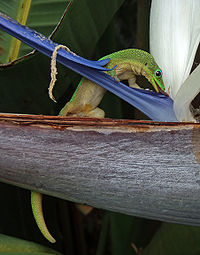 Gold dust day gecko licking nectar from the flower of a Strelitzia plant, also known as "bird of paradise."
Gold dust day gecko licking nectar from the flower of a Strelitzia plant, also known as "bird of paradise."
Family Gekkonidae
- Subfamily Aeluroscalabotinae
- Genus Aeluroscalabotes, (monotypic) (A. felinus), Southeast Asia
- Subfamily Diplodactylinae, 17 genera, found in Oceaniay
- Genus Bavayia (11 species)
- Genus Carphodactylus (monotypic)
- Genus Crenadactylus (monotypic)
- Genus Diplodactylus (40 species)
- Genus Eurydactylodes (4 species)
- Genus Hoplodactylus (10 species)
- Genus Lucasium (monotypic)
- Genus Naultinus (8 species)
- Genus Nephrurus (11 species)
- Genus Oedura (16 species)
- Genus Phyllurus
- Genus Pseudothecadactylus
- Genus Rhacodactylus
- Genus Rhynchoedura
- Genus Saltuarius
- Genus Strophurus
- Genus Underwoodisaurus
- Subfamily Eublepharinae, 5 genera
- Genus Coleonyx
- Genus Eublepharis
- Genus Goniurosaurus
- Genus Hemitheconyx
- Genus Holodactylus
- Subfamily Gekkoninae, 74 genera worldwide, some of the biggest genera are:
- Genus Cyrtodactylus, bent-toed geckos
- Genus Gehyra, Web-toed Geckos or Dtellas
- Genus Gekko, true geckos
- Genus Hemidactylus, house geckos
- Genus Phelsuma, day geckos, most are endemic to Madagascar.
- Genus Phyllodactylus, leaf-toed geckos
- ...
- Subfamily Teratoscincinae, wonder geckos
- Genus Teratoscincus (45 species)
Common species of geckos
Leopard gecko-most commonly domesticated gecko
- Pachydactylus, genus of geckos of which there are many species.
- Bibron's gecko, Pachydactylus bibroni — Native to Southern Africa, this hardy arboreal gecko is considered a household pest.
- Crocodile gecko or Moorish gecko, Tarentola mauritanica — very strong and heavily built for their size usually growing up to 15 cm (6 in). They are commonly found in the Mediterranean region from the Iberian Peninsula and southern France to Greece and northern Africa. Their most distinguishing characteristic is their pointed head and spiked skin with their tail resembling that of a crocodile's.
- Cyrtopodion, genus of geckos of which there are many species.
- Cyrtopodion brachykolon; commonly known as "bent-toed gecko", found in north-western Pakistan.
- Rhacodactylus, genus of Geckos of which there are a few species.
- Suras Gecko belonging to the genus Rhacodactylus.
- Crested gecko, Rhacodactylus ciliatus — Believed extinct until rediscovered in 1994. Gaining in popularity as a pet.
- Gargoyle gecko, Rhacodactylus auriculatus — commonly known as the New Caledonian bumpy gecko or gargoyle gecko.
- Gold dust day gecko (Phelsuma laticauda laticauda (Boettger, 1880) (syn. Pachydactylus laticauda Boettger, 1880)) is a diurnal subspecies of geckos. It lives in northern Madagascar and on the Comoros. It is also an introduced species in Hawaii.
- Golden Gecko, Gekko ulikovskii — native to the warm rainforests of Vietnam.
- Hemidactylus, genus of geckos of which many varieties belong.
- Common House Gecko, Hemidactylus frenatus — A species that thrives around man and human habitation structures in the tropics and subtropics world wide.
- Indo-Pacific Gecko, Hemidactylus garnotii — Also known as a fox gecko because of its long, narrow snout. This species is found in houses throughout the tropics. This gecko may eat leafcutter ants.
- New Caledonian giant gecko, Rhacodactylus leachianus — first described by Cuvier in 1829, is the largest of the Rhacodactylus geckos.
- Leopard gecko, Eublepharis macularius — The most common gecko kept as a pet is the leopard gecko, which does not have toe pads with setae, but rather claws. These enable it to more easily climb on rough surfaces like tree bark. This gecko cannot climb the glass of a terrarium. The leopard gecko tends to be docile and calm. This gecko can eat butterworms, cockroaches, crickets, mealworms, waxworms, superworms, and pink mice.
- Mediterranean gecko, Hemidactylus turcicus — residential and wild, introduced species (USA).
- Mourning gecko, originally an East Asian and Pacific species, Lepidodactylus lugubris is equally at home in the wild as in residential neighborhoods. Found in Hawaii, it may have been an early Polynesian introduction. A parthenogenic species. There is a report from Hawaii of someone having seen a larger gecko of this type eating a smaller one (or rather, running away from view with a smaller gecko halfway out of its mouth) on three or more occasions.[citation needed]
- Ptychozoon, — a genus of arboreal gecko from Southeast Asia, known as Flying Geckos or Parachute Geckos, has wing-like flaps from the neck to the upper leg, to help it conceal itself on trees and provide lift while jumping.
- Stump-toed gecko, Gehyra mutilata (Peropus mutilatus) — This gecko, commonly referred to as a gheckl, can vary its color from very light to very dark to blend into a background. At home in the wild as well as in residential neighborhoods.
- Tree gecko, Hemiphyllodactylus typus — Tree geckos are forest dwellers.
- Tokay gecko, Gekko gecko — a large, common, Southeast Asian gecko known for its aggressive temperament, loud mating calls, and bright markings.
- Western banded gecko, Coleonyx variegatus — Native to southwestern United States and northwest Mexico.
- Dwarf gecko, Sphaerodactylus ariasae — native to the Caribbean islands, and the world's smallest lizard
See also
References
- ^ Arnold, E.N., & Poinar, G. (2008). "A 100 million year old gecko with sophisticated adhesive toe pads, preserved in amber from Myanmar (abstract)". Zootaxa. http://www.mapress.com/zootaxa/2008/f/z01847p068f.pdf. Retrieved August 12, 2009.
- ^ gecko, n. Oxford English Dictionary Second edition, 1989; online version September 2011. Accessed 29 October 2011. Earlier version first published in New English Dictionary, 1898.
- ^ Piper, Ross (2007), Extraordinary Animals: An Encyclopedia of Curious and Unusual Animals, Greenwood Press.
- ^ Huber, G., et al. (2005). "Evidence for capillarity contributions to gecko adhesion from single spatula nanomechanical measurements". Proceedings of the National Academy of Sciences 102: 16293. doi:10.1073/pnas.0506328102. PMC 1283435. PMID 16260737. http://www.pubmedcentral.nih.gov/articlerender.fcgi?tool=pmcentrez&artid=1283435.
- ^ Chen, B.; Gao, H. (2010). "An alternative explanation of the effect of humidity in gecko adhesion: stiffness reduction enhances adhesion on a rough surface". Int JAppl Mech 2: 1–9. doi:10.1142/s1758825110000433.
- ^ a b Puthoff, J. B., et al.. "Changes in materials properties explain the effects of humidity on gecko adhesion". J Exp Biol 213: 3699–3704. doi:10.1242/jeb.047654.
- ^ a b Prowse, M. S., et al.. "Effects of humidity on the mechanical properties of gecko setae". Acta Biomater 7: 733–738. doi:10.1016/j.actbio.2010.09.036.
- ^ a b c d Hansen, W. R.; Autumn, K. (2005). "Evidence for self-cleaning in gecko setae". PNAS 102 (2): 385–389. doi:10.1073/pnas.0408304102. PMC 544316. PMID 15630086. http://www.pubmedcentral.nih.gov/articlerender.fcgi?tool=pmcentrez&artid=544316. "Setae occur in uniform arrays on overlapping lamellar pads at a density of 14,400 per mm2"
- ^ How Geckos Stick to Walls.
- ^ Why do the gecko's feet not stick to a teflon surface?.
- ^ Autumn, Kellar; et al. (2002). "Evidence for van der Waals adhesion in gecko setae". PNAS 99 (19): 12252–12256. doi:10.1073/pnas.192252799. PMC 129431. PMID 12198184. http://www.pubmedcentral.nih.gov/articlerender.fcgi?tool=pmcentrez&artid=129431.
- ^ Kellar Autumn, Scientific American: Ask the experts. Accessed 5 June 2007.
- ^ Lee, Haeshin; Lee, Bruce P.; Messersmith, Phillip B. (2007). "A reversible wet/dry adhesive inspired by mussels and geckos". Nature 448 (7151): 338–341. doi:10.1038/nature05968. PMID 17637666.
Further reading
- Forbes, Peter (4th Estate, London 2005) The Gecko's Foot—Bio Inspiration: Engineered from Nature ISBN 0-00-717990-1 in H/B
- Zug, George. Speciation and Dispersal in a Low Diversity Taxon: The Slender Geckos Hemiphyllodactylus (Reptilia, Gekkonidae). Smithsonian Contributions to Zoology, no. 631. Washington, D.C.: Smithsonian Institution Scholarly Press, 2010.
External links
Categories:- Geckos
- Gekkonidae
- Pet lizards
- Urban animals
- Subfamily Aeluroscalabotinae
Wikimedia Foundation. 2010.



